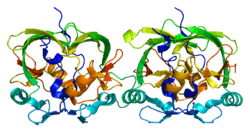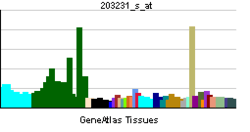Ataxin 1
Ataxin-1 is a protein that in humans is encoded by the ATXN1 gene.[1][2]
Mutations in this gene have been linked to neuronal death in suffers of spinocerebellar ataxia type 1, an inherited neurodegenerative disease characterized by a progressive loss of cerebellar neurons. Pathogenic ATXN1 contains an abnormally elongated stretch of the amino acid glutamine. This causes the protein to spontaneously misfold and form aggregates.[3] It has been shown that other neuronal proteins can modulate the formation of Ataxin-1 aggregates and that this in turn may affect aggregate-induced toxicity.[4]
Interactions
Ataxin 1 has been shown to interact with:
References
- ↑ Volz A, Fonatsch C, Ziegler A (Jun 1992). "Regional mapping of the gene for autosomal dominant spinocerebellar ataxia (SCA1) by localizing the closely linked D6S89 locus to 6p24.2----p23.05". Cytogenet Cell Genet 60 (1): 37–9. doi:10.1159/000133291. PMID 1582256.
- ↑ "Entrez Gene: ATXN1 ataxin 1".
- ↑ Shastry BS. (2003). "Neurodegenerative disorders of protein aggregation.". Neurochem Int. 43 (1): 1–7. doi:10.1016/s0197-0186(02)00196-1. PMID 12605877.
- ↑ Petrakis S, Raskó T, Russ J, Friedrich RP, Stroedicke M, Riechers SP, Muehlenberg K, Möller A, Reinhardt A, Vinayagam A, Schaefer MH, Boutros M, Tricoire H, Andrade-Navarro MA, Wanker EE (Aug 2012). "Identification of human proteins that modify misfolding and proteotoxicity of pathogenic ataxin-1". PLoS Genet. 8 (8): e1002897. doi:10.1371/journal.pgen.1002897. PMID 22916034.
- ↑ Al-Ramahi I, Lam YC, Chen HK, de Gouyon B, Zhang M, Pérez AM, Branco J, de Haro M, Patterson C, Zoghbi HY, Botas J (2006). "CHIP protects from the neurotoxicity of expanded and wild-type ataxin-1 and promotes their ubiquitination and degradation". J. Biol. Chem. 281 (36): 26714–24. doi:10.1074/jbc.M601603200. PMID 16831871.
- ↑ de Chiara C, Menon RP, Dal Piaz F, Calder L, Pastore A (2005). "Polyglutamine is not all: the functional role of the AXH domain in the ataxin-1 protein". J. Mol. Biol. 354 (4): 883–93. doi:10.1016/j.jmb.2005.09.083. PMID 16277991.
- ↑ Tsuda H, Jafar-Nejad H, Patel AJ, Sun Y, Chen HK, Rose MF, Venken KJ, Botas J, Orr HT, Bellen HJ, Zoghbi HY (2005). "The AXH domain of Ataxin-1 mediates neurodegeneration through its interaction with Gfi-1/Senseless proteins". Cell 122 (4): 633–44. doi:10.1016/j.cell.2005.06.012. PMID 16122429.
- ↑ Mizutani A, Wang L, Rajan H, Vig PJ, Alaynick WA, Thaler JP, Tsai CC (2005). "Boat, an AXH domain protein, suppresses the cytotoxicity of mutant ataxin-1". EMBO J. 24 (18): 3339–51. doi:10.1038/sj.emboj.7600785. PMC 1224676. PMID 16121196.
- ↑ Park Y, Hong S, Kim SJ, Kang S (2005). "Proteasome function is inhibited by polyglutamine-expanded ataxin-1, the SCA1 gene product". Mol. Cells 19 (1): 23–30. PMID 15750336.
- ↑ Irwin S, Vandelft M, Pinchev D, Howell JL, Graczyk J, Orr HT, Truant R (2005). "RNA association and nucleocytoplasmic shuttling by ataxin-1". J. Cell. Sci. 118 (Pt 1): 233–42. doi:10.1242/jcs.01611. PMID 15615787.
- ↑ Suter, B.; Fontaine, J.-F.; Yildirimman, R.; Rasko, T.; Schaefer, M. H.; Rasche, A.; Porras, P.; Vazquez-Alvarez, B. M.; Russ, J.; Rau, K.; Foulle, R.; Zenkner, M.; Saar, K.; Herwig, R.; Andrade-Navarro, M. A.; Wanker, E. E. (28 December 2012). "Development and application of a DNA microarray-based yeast two-hybrid system". Nucleic Acids Research. pp. 1496–1507. doi:10.1093/nar/gks1329.
- ↑ Hong S, Ka S, Kim S, Park Y, Kang S (May 2003). "p80 coilin, a coiled body-specific protein, interacts with ataxin-1, the SCA1 gene product". Biochim. Biophys. Acta 1638 (1): 35–42. doi:10.1016/s0925-4439(03)00038-3. PMID 12757932.
- 1 2 Hong S, Lee S, Cho SG, Kang S (Jun 2008). "UbcH6 interacts with and ubiquitinates the SCA1 gene product ataxin-1". Biochem. Biophys. Res. Commun. 371 (2): 256–60. doi:10.1016/j.bbrc.2008.04.066. PMID 18439907.
- ↑ Koshy B, Matilla T, Burright EN, Merry DE, Fischbeck KH, Orr HT, Zoghbi HY (Sep 1996). "Spinocerebellar ataxia type-1 and spinobulbar muscular atrophy gene products interact with glyceraldehyde-3-phosphate dehydrogenase". Hum. Mol. Genet. 5 (9): 1311–8. doi:10.1093/hmg/5.9.1311. PMID 8872471.
- ↑ Hong S, Kim SJ, Ka S, Choi I, Kang S (Jun 2002). "USP7, a ubiquitin-specific protease, interacts with ataxin-1, the SCA1 gene product". Mol. Cell. Neurosci. 20 (2): 298–306. doi:10.1006/mcne.2002.1103. PMID 12093161.
External links
- GeneReviews/NIH/NCBI/UW entry on Spinocerebellar Ataxia Type 1
- ataxin-1 at the US National Library of Medicine Medical Subject Headings (MeSH)
This article incorporates text from the United States National Library of Medicine, which is in the public domain.


